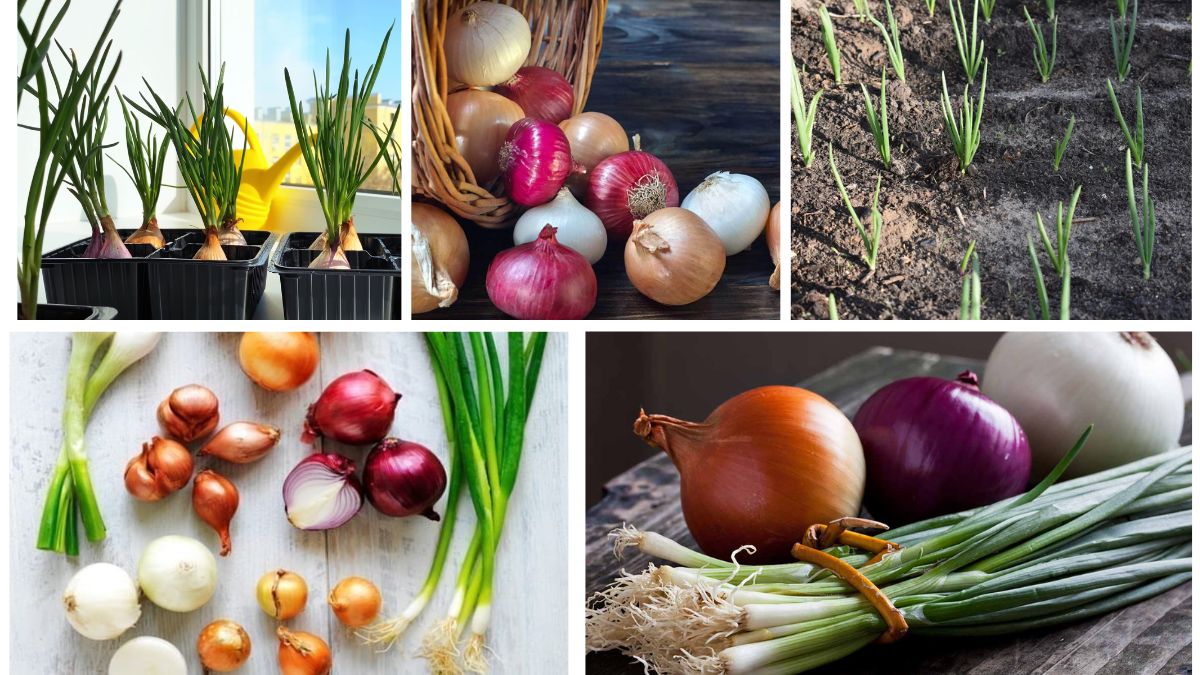Onions are among the most essential and versatile vegetables in kitchens around the world. With their pungent aroma, layered texture, and rich flavor, they form the base of countless recipes—from soups and stews to salads and sauces. Beyond their culinary importance, onions are also packed with nutrients, including vitamin C, vitamin B6, and antioxidants, which provide various health benefits.
Growing onions at home is not only rewarding but also surprisingly easy. Whether you have a backyard garden, raised beds, or even containers on a balcony, you can cultivate fresh onions without the need for commercial farming. This guide will walk you step by step through the process of growing onions easily at home, including varieties, planting techniques, care tips, and harvesting methods.
Why Grow Onions at Home?

Homegrown onions offer several advantages over store-bought varieties:
- Freshness: Harvested onions have better flavor and texture.
- Cost Savings: Growing onions at home is inexpensive compared to buying premium-quality produce.
- Variety Choices: You can grow unique onion varieties not commonly available in stores.
- Pesticide-Free: Home cultivation allows you to control chemicals and grow organically.
- Satisfaction: Watching onions grow from tiny bulbs to mature vegetables is highly rewarding.
Step 1: Choosing the Right Onion Variety

Onions come in various types, and selecting the right variety depends on your climate, growing season, and personal preference.
- Short-Day Onions: Suitable for southern regions with mild winters. They require 10–12 hours of daylight to form bulbs. Examples: Texas Sweet, Granex.
- Long-Day Onions: Best for northern regions with long summer days. They need 14–16 hours of daylight. Examples: Walla Walla, Yellow Sweet Spanish.
- Day-Neutral Onions: Adaptable to most regions and grow reliably regardless of day length. Examples: Candy, Super Star.
Additionally, onions can be grown from seeds, sets (small bulbs), or transplants. Sets and transplants are easier and faster for beginners, while seeds offer a wider selection of varieties.
Step 2: Preparing the Soil
Onions thrive in loose, fertile, and well-draining soil. Proper soil preparation ensures healthy roots and robust bulb development.
- Soil Type: Sandy loam or loamy soil is ideal. Heavy clay or poorly drained soil can cause rot.
- pH Level: Aim for a soil pH between 6.0–7.0. You can test soil acidity and amend with lime if needed.
- Nutrient Enrichment: Mix in well-rotted compost or organic manure before planting to provide essential nutrients.
- Bed Preparation: Loosen soil to a depth of 8–10 inches to accommodate growing bulbs.
Step 3: Planting Onions

From Seeds
- Start seeds indoors 8–10 weeks before the last frost.
- Sow seeds ¼ inch deep in seed trays with seed-starting soil.
- Keep soil moist and provide 6–8 hours of light daily.
- Transplant seedlings when they reach 4–6 inches tall.
From Sets or Bulbs
- Plant small onion bulbs directly into the soil in early spring.
- Place sets 1 inch deep with the pointed end facing upward.
- Space onions 4–6 inches apart, with rows 12–18 inches apart.
From Transplants
- Buy nursery-grown onion seedlings.
- Plant them 1 inch deep and 4–6 inches apart.
Proper spacing allows sufficient room for bulb growth and improves air circulation, reducing disease risk.
Step 4: Watering and Fertilization
- Watering: Onions need consistent moisture, especially during bulb formation. Water 1 inch per week, adjusting for rainfall. Avoid overwatering, which can lead to rot.
- Mulching: Apply a layer of straw or dried leaves to conserve moisture, suppress weeds, and maintain soil temperature.
- Fertilization: Use a nitrogen-rich fertilizer during early growth stages. Reduce nitrogen when bulbs start forming to encourage size rather than leafy growth.
Step 5: Pest and Disease Management

Onions are relatively hardy but can face challenges from pests and diseases.
- Common Pests: Onion maggots, thrips, and aphids. Control with insecticidal soap or companion planting (e.g., carrots or chamomile).
- Diseases: Downy mildew, white rot, and neck rot. Prevent by practicing crop rotation, ensuring good drainage, and removing infected plants promptly.
- Weed Control: Mulching and regular hand weeding prevent competition for nutrients.
Step 6: Hilling and Care
As onions grow, gently hill soil around the base of the plants to support stems and promote larger bulb formation. Remove weeds regularly and ensure sunlight exposure for 6–8 hours per day, as onions are sun-loving plants.
Step 7: Harvesting Onions

Knowing when and how to harvest is essential for maximizing quality and storage life.
- Signs of Maturity: Bulbs are ready when tops start to yellow and fall over.
- Harvesting Method: Gently lift bulbs with a fork or hand tool, taking care not to bruise them.
- Curing: Allow onions to dry in a well-ventilated, shaded area for 2–3 weeks to form a protective skin.
- Storage: Once cured, store onions in a cool, dry place with good air circulation. Properly cured onions can last for several months.
Container and Small Space Gardening
For those with limited space, onions can be successfully grown in containers:
- Container Size: Use at least 8–12 inch deep pots.
- Soil: Well-draining potting mix enriched with compost.
- Watering: Ensure consistent moisture but avoid waterlogging.
- Varieties: Short-day or day-neutral onions work best in containers due to shorter growing periods.
Container gardening allows urban gardeners to enjoy fresh onions year-round without a traditional garden plot.
Tips for Maximum Success
- Rotate crops yearly to prevent disease buildup.
- Harvest green onions early for tender, mild-flavored stems.
- Companion plant onions with carrots, lettuce, or beets to deter pests.
- Monitor weather and provide frost protection if necessary in early spring.
- Avoid over-fertilization once bulbs begin to swell; excess nitrogen leads to leafy growth instead of larger onions.
Conclusion
Growing onions at home is a rewarding and practical endeavor that can provide a steady supply of fresh, flavorful bulbs throughout the year. By selecting the right variety, preparing nutrient-rich soil, planting correctly, and following simple care practices—including watering, hilling, pest management, and harvesting—you can enjoy a successful onion harvest with minimal effort.
Whether you have a large backyard, raised beds, or a small balcony, homegrown onions are an achievable and satisfying addition to your garden. With patience and attention to detail, you can cultivate healthy, vibrant onions that elevate your meals, enhance your garden’s beauty, and provide a sense of accomplishment.





